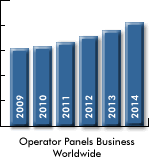
Market for operator panels driven by creative destruction
January 11, 2010
By Manufacturing AUTOMATION
 The competitive market for operator panels faces technological change and ongoing movement. The worldwide market for operator panels declined drastically in 2009 and will recover slowly but steadily after the extreme years of 2007 and 2008. Beneath the relatively stable growth, however, is a changing competitive landscape and ongoing technological development.
The competitive market for operator panels faces technological change and ongoing movement. The worldwide market for operator panels declined drastically in 2009 and will recover slowly but steadily after the extreme years of 2007 and 2008. Beneath the relatively stable growth, however, is a changing competitive landscape and ongoing technological development.
A comparably new segment in this mature market is the market for automation panels (panels with built-in control functionality). These panels are getting close to the functionality of embedded panel PCs. In this market, not only is strong growth expected, but also new competitors. As this technology matures, it is likely that Asian suppliers, especially from Taiwan, will enter this market.
“The market for operator panels is divided into two parts: suppliers that offer the panel plus controller business and suppliers that sell operator panels alone. During the coming years, technology will increasingly shift towards automation panels and this technological change will significantly alter the competitive landscape,” according to analyst Florian Güldner, the principal author of ARC’s Operator Panel Worldwide Outlook.
Demand for solutions
The current economic situation has resulted in consolidation among the companies that buy operator panels. For example, in 1988 there were roughly 30,000 OEMs and system integrators delivering intermediate products to automotive manufacturers. By 2000, there were 5,600 suppliers left.
Increasingly, OEMs and end user customers prefer to purchase broader solutions packages from suppliers or third-party system integrators that enable one-stop shopping. Many suppliers look to expand their offerings from components-only to a solutions business in markets such as steel processing, pulp & paper, and automotive.
Commodity hardware
Operator panels that use Microsoft Windows CE operating system began to appear in 1999. These devices promised to integrate easily into plant systems at a reasonable cost by leveraging the communications support offered by Windows CE. As operator panel hardware moves toward commodity status, software becomes more important and plays an increasingly important role in purchasing decisions. Automation suppliers increasingly leverage their modular hardware platforms and modularization within their product portfolio.
Eastern Europe and Russia: The Wild East
Following a prolonged expansion starting in the mid nineties, it became obvious that there is, in fact, not “one” Eastern Europe region. Many countries (Latvia, Belarus, Lithuania, Estonia, and Hungary) are not experiencing a slowdown, but rather a free fall. In contrast to these struggling countries, Slovakia, Slovenia, Czech Republic, and Poland have weathered the economic crisis fairly well. Prior to the economic crisis, Hungary and Slovakia suffered from a lack of skilled labor and rising wages have already forced companies such as Leoni to move its wiring harness production from Czech Republic to Belarus. Russia’s economy contracted strongly in 2009, due to its dependency on exports.
www.arcweb.com
Advertisement
- Fluke Networks acquires ClearSight Networks
- New collaborations for North American wind energy industry